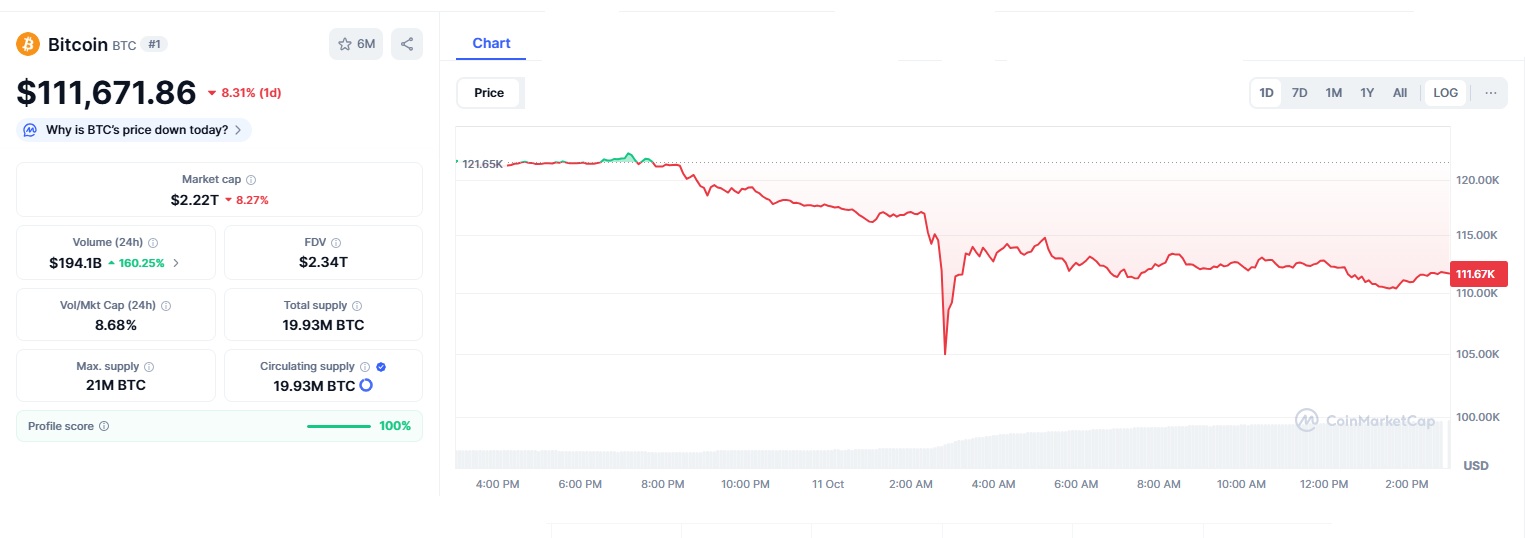In early October 2025, the cryptocurrency market experienced a sudden and dramatic drop. Bitcoin, the largest cryptocurrency, fell below $110,000 after trading around $117,000, wiping out billions in leveraged positions.
On Friday, the market took a sharp downturn, resulting in over $7 billion in losses for traders who had expected prices to rise. Tensions between the U.S. and China increased when Trump stated he would raise tariffs on Chinese goods. This was in response to China’s restrictions on exporting rare earth metals. After the traditional markets closed for the week, Trump announced on Truth Social that he would implement an additional 100% tariff starting November 1. This combination of political news and market speculation caused panic among traders, leading to massive liquidations and a sharp decline across the crypto market.
When the post went live, Bitcoin’s price dropped by $3,000 right away, falling more than 10% within 24 hours. Other major cryptocurrencies also took a hit. Ethereum’s price decreased by 16%, dropping below $3,700. Altcoins like XRP, Solana, Dogecoin, Cardano, and Chainlink saw their prices fall by 20% to 40%. At the start of the crash, there was a $600 million sell-off, including $235 million in Ethereum investments.
The chart below summarizes the price movements during this crash:
| Cryptocurrency | Price Before Crash | Price After Crash | % Drop | Notes |
|---|---|---|---|---|
| Bitcoin (BTC) | $117,000 | $104,000 | 11.11% | Triggered $7B liquidations |
| Ethereum (ETH) | $4,400 | $3,700 | 16% | Leading decline in altcoins |
| XRP | $3.10 | $2.40 | 22.5% | Heavy volatility |
| Solana (SOL) | $320 | $240 | 25% | Short-term panic selling |
| Dogecoin (DOGE) | $0.72 | $0.50 | 30.5% | Market-wide selloff |
| Cardano (ADA) | $1.80 | $1.08 | 40% | Largest drop among majors |
| Chainlink (LINK) | $35 | $21 | 40% | Contagion effect across DeFi |
This rapid sell-off demonstrates the cascading effects leveraged trading can have on the market. Traders using borrowed funds were forced to close positions, amplifying price declines across multiple assets.
While the news screams "Trade War" and the charts bleed red (10% $BTC, 30% Altcoin pain), remember what you own.
$7 Billion in liquidations is a MASSIVE wealth transfer. The FUD is shaking out the tourists. Geopolitical risks are temporary; decentralization is forever.
If you… pic.twitter.com/NaGSV0xKjy
— NekoZ (@NekozTek) October 11, 2025
The flash crash was primarily driven by trade war fears between the U.S. and China. Trump’s tariffs and export restrictions created uncertainty in global markets. Bitcoin and other cryptocurrencies are often seen as alternative stores of value, but their high volatility makes them especially sensitive to sudden economic news. When traders feared a prolonged trade conflict, panic selling triggered massive liquidations, accelerating the market decline.
While a flash crash can be alarming, it may also present opportunities for some investors. The $7 billion in liquidations removed weaker positions, potentially setting the stage for a rebound. Bitcoin’s finite supply and growing institutional interest suggest that strong support levels could lead to recovery, possibly pushing BTC back above $120,000 if buyers step in. However, there is also the risk of further declines. If trade tensions escalate, Bitcoin could revisit lows around $90,000 or even lower. Altcoins, which tend to be more volatile, remain particularly vulnerable to large swings during geopolitical crises.
What Next For Bitcoin
The October 2025 market crash highlights how quickly cryptocurrency values can change due to outside influences. Political events, like trade tensions between big economies, can cause sudden drops and large losses. Although this unpredictability is risky, it can also offer chances for investors who know how to navigate the market and handle risks wisely. Whether Bitcoin will rise again or keep falling depends on future trade relationships and how people react to the crash. The $7 billion lost in liquidations shows how sensitive cryptocurrencies are to global events and why careful trading is crucial.
Stay informed with daily updates from Blockchain Magazine on Google News. Click here to follow us and mark as favorite: [Blockchain Magazine on Google News].
Disclaimer: Any post shared by a third-party agency are sponsored and Blockchain Magazine has no views on any such posts. The views and opinions expressed in this post are those of the clients and do not necessarily reflect the official policy or position of Blockchain Magazine. The information provided in this post is for informational purposes only and should not be considered as financial, investment, or professional advice. Blockchain Magazine does not endorse or promote any specific products, services, or companies mentioned in this posts. Readers are encouraged to conduct their own research and consult with a qualified professional before making any financial decisions.
